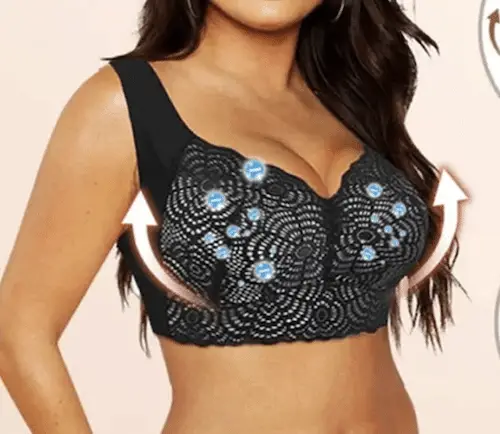Table of Contents
In the world of women’s fashion, underwire bras have long been a staple for those seeking a little extra support and lift. However, amidst all the comfort and style these bras provide, a question lingers in the minds of many: are underwire bras bad for your health? With 50 thought-provoking questions about women’s bras, this article aims to shed light on the subject and uncover the truth behind this widely debated issue. Whether you’re a bra enthusiast or merely curious, we’ll explore the potential risks and benefits associated with underwire bras, allowing you to make an informed decision about what’s best for your well-being. So, let’s dive into this captivating world of brassieres and discover what lies beneath the underwire.
Factors to Consider
Material used in underwire bras
When it comes to underwire bras, one of the essential factors to consider is the material used in their construction. The underwire itself is typically made of metal, such as stainless steel or plastic-coated metal. It is crucial to ensure that the material used is high-quality and non-toxic, as it will be in direct contact with your skin for extended periods. Look for bras with underwires that are encased in fabric to provide additional comfort and prevent any potential irritation.
Fit and size of the bra
Another critical factor to consider when wearing underwire bras is the fit and size. Ill-fitting bras can cause discomfort and potential health concerns. It is essential to get professionally fitted to ensure you are wearing the correct size. A well-fitting underwire bra should sit flat against your rib cage without digging into your breast tissue or causing any pinching or poking sensations. Remember that your bra size can fluctuate over time, so it is crucial to reassess your size regularly and invest in new bras when needed.
Frequency and duration of wear
The frequency and duration of wear are additional factors to consider when it comes to underwire bras. Wearing an underwire bra every day for extended periods can potentially increase the risk of health concerns. It is essential to give your body breaks from underwire bras to allow your breasts to breathe and recover. Consider incorporating alternative bra options, such as wireless bras or bralettes, into your wardrobe rotation to minimize the amount of time spent wearing underwire bras.
Potential Health Risks
Discomfort and pain
One of the most common health concerns associated with underwire bras is discomfort and pain. If the bra is ill-fitting or the underwire is not properly positioned, it can dig into your breast tissue, causing discomfort and even pain. It is essential to choose a bra that offers proper support while still remaining comfortable throughout the day. If you experience any discomfort or pain while wearing an underwire bra, it may be a sign that you need to reassess your size or try alternative bra options.
Breathing difficulties
Another potential health risk associated with underwire bras is breathing difficulties. If the underwire is too tight or positioned too high on your chest, it may restrict your lung expansion and make it more challenging to breathe deeply. It is important to ensure that your underwire bra is neither too tight nor too loose, allowing your chest to expand and contract naturally during breathing. If you experience any breathing difficulties while wearing an underwire bra, consider getting professionally fitted or exploring other bra options.
Skin irritation and allergies
Underwire bras, especially if made with low-quality materials, can potentially cause skin irritation and allergies. The metal or plastic-coated underwire may rub against your skin, leading to redness, itching, or even rashes. To minimize the risk of skin irritation or allergies, opt for bras made with hypoallergenic materials and ensure that the underwire is properly encased in fabric. Additionally, it’s important to maintain good hygiene practices by regularly washing your bras to eliminate any potential irritants.
Lymphatic system issues
Some concerns have been raised regarding the potential impact of underwire bras on the lymphatic system. The lymphatic system plays a crucial role in maintaining overall health by removing toxins and waste from the body. Some believe that the pressure exerted by underwire bras may impede the flow of lymph fluid, potentially leading to lymphatic system issues. However, more research is needed to establish a definitive link between underwire bras and lymphatic system problems.
Breast Health Concerns
Restricted movement and blood flow
One of the concerns when wearing underwire bras is restricted movement and blood flow in the breast tissue. The underwire can limit the natural movement of your breasts, potentially affecting circulation and lymphatic drainage. Restricted blood flow could hinder the delivery of essential nutrients and oxygen to the breast tissue, which may have implications for overall breast health. To mitigate this risk, it is crucial to choose underwire bras that allow for freedom of movement and do not compress the breast tissue excessively.
Impact on breast tissue
There are differing opinions on the impact of underwire bras on breast tissue. Some believe that the pressure exerted by underwire bras may lead to issues such as fibrocystic breasts or mastitis. However, there is currently limited scientific evidence to support these claims. It is important to listen to your body and pay attention to any changes in your breast health while wearing underwire bras. If you notice any abnormalities or discomfort, consult with a healthcare professional for a proper evaluation.
Effect on breastfeeding
Underwire bras can present challenges for breastfeeding mothers. The underwire itself may put pressure on the milk ducts, potentially leading to clogged ducts or mastitis. It is generally recommended to avoid wearing underwire bras during breastfeeding to ensure optimal milk flow and breast health. Instead, opt for wire-free nursing bras that provide adequate support and easy access for nursing.
Underwire Bra Myths
Underwire bras cause breast cancer
One prevailing myth surrounding underwire bras is that they cause breast cancer. However, there is no scientific evidence to support this claim. Multiple studies have been conducted to examine the correlation between bra wearing habits and breast cancer risk, and no definitive link has been found. It is important to rely on credible scientific research when evaluating potential health risks and not be swayed by unfounded myths.
Underwire bras decrease breast size
Another misconception is that underwire bras can decrease breast size. The truth is that underwire bras do not have any effect on breast size. However, a well-fitting underwire bra can provide lift and support, enhancing the appearance and shape of your breasts. It is important to choose a bra size that fits you properly to achieve the desired aesthetic results.
Underwire bras are the only option for support
Contrary to popular belief, underwire bras are not the only option for support. While underwire bras provide additional lift and shaping, there are numerous alternative bra options available that offer adequate support. Wireless bras, sports bras, bralettes, and soft cup bras can all provide support and comfort without the potential health risks associated with underwire bras. It is essential to explore different bra styles and find the one that best suits your needs and preferences.
Alternative Bra Options
Wireless bras
Wireless bras, also known as soft cup bras, are an excellent alternative to underwire bras. They rely on stretchy fabrics and supportive designs to provide lift and shaping without the use of underwires. Wireless bras can be just as supportive and comfortable as underwire bras, especially when properly fitted. They are a great option for everyday wear and can be particularly beneficial for those who prioritize comfort and want to avoid potential health risks associated with underwire bras.
Sports bras
Sports bras are designed to provide maximum support and minimize breast movement during physical activity. They are typically constructed with stretchy, breathable fabrics and a wide elastic band for added support. Sports bras offer excellent comfort and can be an excellent alternative to underwire bras, particularly for those with an active lifestyle. They come in various levels of support, ensuring that you find the right level of compression and comfort for your needs.
Bralettes
Bralettes have gained popularity in recent years for their comfort and stylish designs. They are typically made of soft fabrics, such as lace or cotton, and offer minimal support. Bralettes are perfect for those seeking a more relaxed and natural look without sacrificing comfort. While they may not provide the same level of support as an underwire bra, they are an excellent option for those who prioritize comfort and want to give their breasts a break from the constraints of underwire bras.
Soft cup bras
Soft cup bras are similar to underwire bras in terms of construction, but without the underwire. They offer shaping and support through the use of seaming, padding, or molded cups. Soft cup bras can provide a comfortable and flattering fit, especially when made with high-quality materials. They are suitable for everyday wear and can be a great alternative to underwire bras, particularly if you prefer a more natural and comfortable feel.
Tips for Wearing Underwire Bras Safely
Choose the right size
To wear underwire bras safely, it is crucial to choose the right size. Get professionally fitted to ensure you are wearing the correct bra size. A well-fitting underwire bra should sit flat against your rib cage without digging into your breast tissue or causing any discomfort. Avoid wearing bras that are too tight or too loose, as they can increase the risk of health issues. Regularly reassess your bra size, especially after significant changes in weight or breast size, to ensure optimal comfort and support.
Opt for comfortable materials
When selecting underwire bras, opt for bras made with comfortable materials. Look for bras with soft, breathable fabrics that minimize the risk of skin irritation or allergies. bras with padded underwires or fabric encased wires can provide additional comfort and prevent potential discomfort caused by direct contact with the underwire. Additionally, it is essential to regularly wash your bras to maintain hygiene and prevent any buildup of allergens or irritants.
Allow your breasts to breathe
To promote breast health, it is essential to allow your breasts to breathe. While underwire bras can provide support and shaping, it is crucial to give your breasts breaks from wearing them. Incorporate wireless bras, bralettes, or other alternative bra options into your wardrobe rotation to minimize the amount of time spent in underwire bras. This can help promote better circulation and lymphatic drainage, reducing the risk of potential health issues.
Take breaks from wearing underwire bras
In addition to incorporating alternative bra options, taking breaks from wearing underwire bras is essential for your breast health. Take off your underwire bra when at home or during relaxation times to give your breasts a break from the pressures of a structured bra. This can help alleviate any discomfort or pain associated with prolonged underwire bra wear and promote a healthier breast environment.
Impact on Body Image and Mental Health
Body dissatisfaction
Wearing underwire bras can sometimes contribute to body dissatisfaction, particularly if the bra does not fit well or causes discomfort. Ill-fitting bras can affect the way your clothes fit and can make you feel self-conscious about your appearance. It is important to prioritize comfort and find bras that enhance your body confidence. Investing in properly fitting bras and exploring alternative bra options that promote comfort can help combat body dissatisfaction and promote a more positive body image.
Increased anxiety and stress
The discomfort and potential health risks associated with underwire bras can increase anxiety and stress for some individuals. Constantly worrying about the fit, potential health issues, or discomfort can have a negative impact on mental well-being. It is essential to listen to your body, address any concerns or discomfort promptly, and explore alternative bra options if needed. Prioritizing your comfort and well-being can go a long way in reducing anxiety and stress related to underwire bras.
Studies and Expert Opinions
Research on the health effects of underwire bras
While there have been some concerns raised about the potential health effects of wearing underwire bras, scientific research in this area is limited. Studies investigating the direct impact of underwire bras on breast health have yielded mixed results, with no conclusive evidence linking underwire bras to specific health issues. However, it is important to note that individual experiences may vary, and it is always recommended to pay attention to your body and seek advice from healthcare professionals when needed.
Expert recommendations
Experts generally recommend wearing bras that fit well and provide proper support to prevent discomfort and potential health concerns. It is advised to get professionally fitted to ensure you are wearing the correct bra size and explore different bra styles to find the right balance between comfort and support. Additionally, experts also emphasize the importance of allowing your breasts to breathe and taking breaks from wearing underwire bras to promote better breast health.
Personal Experiences and Testimonials
Stories of discomfort and health issues
While personal experiences and testimonials can provide insights into the potential health risks associated with underwire bras, it is important to remember that individual experiences may vary. Some individuals have reported discomfort, pain, or other health issues while wearing underwire bras. Their stories highlight the importance of proper fit, comfort, and listening to your body’s signals. If you are experiencing any discomfort or health concerns, it is advisable to seek professional advice.
Positive experiences with underwire bras
On the other hand, many individuals have also reported positive experiences with underwire bras. For some, underwire bras provide excellent support and shaping, enhancing their body confidence and overall comfort. Properly fitting underwire bras made with high-quality materials can offer the desired lift and support without causing any discomfort or health issues. It is crucial to find the right fit and style that works best for your body and preferences.
Conclusion
When it comes to underwire bras and their potential impact on health, it is essential to consider multiple factors. Factors such as the material used, fit and size, and frequency and duration of wear can all influence the overall comfort and potential health risks associated with underwire bras. While discomfort and potential health concerns exist, it is important to note that personal experiences may vary, and scientific research on the subject is limited. It is crucial to prioritize your comfort, pay attention to your body’s signals, and explore alternative bra options if needed. Ultimately, finding the right balance between comfort, support, and personal preferences is key to maintaining positive breast health and well-being.


